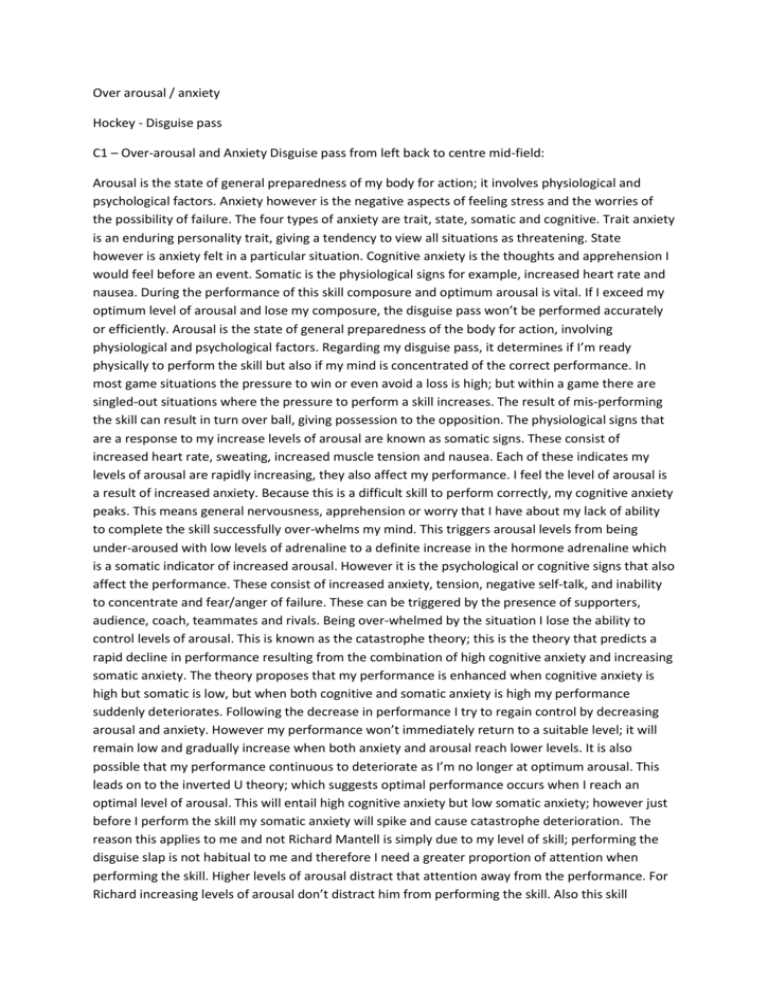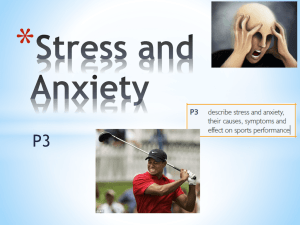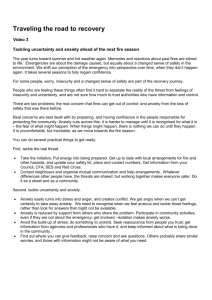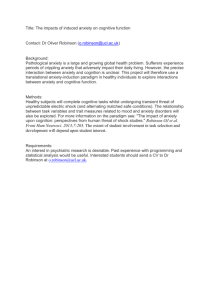File
advertisement

Over arousal / anxiety Hockey - Disguise pass C1 – Over-arousal and Anxiety Disguise pass from left back to centre mid-field: Arousal is the state of general preparedness of my body for action; it involves physiological and psychological factors. Anxiety however is the negative aspects of feeling stress and the worries of the possibility of failure. The four types of anxiety are trait, state, somatic and cognitive. Trait anxiety is an enduring personality trait, giving a tendency to view all situations as threatening. State however is anxiety felt in a particular situation. Cognitive anxiety is the thoughts and apprehension I would feel before an event. Somatic is the physiological signs for example, increased heart rate and nausea. During the performance of this skill composure and optimum arousal is vital. If I exceed my optimum level of arousal and lose my composure, the disguise pass won’t be performed accurately or efficiently. Arousal is the state of general preparedness of the body for action, involving physiological and psychological factors. Regarding my disguise pass, it determines if I’m ready physically to perform the skill but also if my mind is concentrated of the correct performance. In most game situations the pressure to win or even avoid a loss is high; but within a game there are singled-out situations where the pressure to perform a skill increases. The result of mis-performing the skill can result in turn over ball, giving possession to the opposition. The physiological signs that are a response to my increase levels of arousal are known as somatic signs. These consist of increased heart rate, sweating, increased muscle tension and nausea. Each of these indicates my levels of arousal are rapidly increasing, they also affect my performance. I feel the level of arousal is a result of increased anxiety. Because this is a difficult skill to perform correctly, my cognitive anxiety peaks. This means general nervousness, apprehension or worry that I have about my lack of ability to complete the skill successfully over-whelms my mind. This triggers arousal levels from being under-aroused with low levels of adrenaline to a definite increase in the hormone adrenaline which is a somatic indicator of increased arousal. However it is the psychological or cognitive signs that also affect the performance. These consist of increased anxiety, tension, negative self-talk, and inability to concentrate and fear/anger of failure. These can be triggered by the presence of supporters, audience, coach, teammates and rivals. Being over-whelmed by the situation I lose the ability to control levels of arousal. This is known as the catastrophe theory; this is the theory that predicts a rapid decline in performance resulting from the combination of high cognitive anxiety and increasing somatic anxiety. The theory proposes that my performance is enhanced when cognitive anxiety is high but somatic is low, but when both cognitive and somatic anxiety is high my performance suddenly deteriorates. Following the decrease in performance I try to regain control by decreasing arousal and anxiety. However my performance won’t immediately return to a suitable level; it will remain low and gradually increase when both anxiety and arousal reach lower levels. It is also possible that my performance continuous to deteriorate as I’m no longer at optimum arousal. This leads on to the inverted U theory; which suggests optimal performance occurs when I reach an optimal level of arousal. This will entail high cognitive anxiety but low somatic anxiety; however just before I perform the skill my somatic anxiety will spike and cause catastrophe deterioration. The reason this applies to me and not Richard Mantell is simply due to my level of skill; performing the disguise slap is not habitual to me and therefore I need a greater proportion of attention when performing the skill. Higher levels of arousal distract that attention away from the performance. For Richard increasing levels of arousal don’t distract him from performing the skill. Also this skill requires a certain level of control; although it is a gross skill the requirement for accuracy means over arousal would distract from the performance. I would need to be at optimum arousal to perform the skill accurately but also with power. C2 – Over-arousal and Anxiety Disguise pass from left back to centre mid-field: In order to avoid the catastrophe theory and mis-performing the skill I need to overcome my levels of anxiety. As regards to the catastrophe theory I must control my somatic anxiety above all else; as this is the main cause of over-arousal. Somatic anxiety is the physiological responses I get from increased anxiety, these coupled with the cognitive signs (i.e. negative self-talk) will cause arousal to peak and performance to decline. This type of anxiety is state; I know this because it’s not my personality to feel nervous at every situation, which is what trait anxiety suggests. State anxiety is anxiety felt in a particular situation – performing the disguise slap. There are a number of methods to control anxiety for both cognitive and somatic; as I must concentrate on controlling somatic I will focus on those. Bio-Feedback: The first known method is called bio-feedback; this is the monitoring of a physiological variable which is affected by somatic anxiety. I would be attached to a number of different electrical apparatus that will display information on each symptom of somatic anxiety. • Pulsometer – measures Heart Rate • Electromyography – measures muscle tension • Galvanic Skin response – measures sweating • Sphygmomanometer – measures blood pressure • Spirometer – measures breathing rate In practice/training I would have to use these monitors and learn to reduce each physiological variable by trying to think positive or pleasant thoughts, thus reducing the anxiety state associated with that skill. The most common one to use is the heart rate monitor; as increasing heart rate is the easiest way to tell if somatic anxiety is increasing. I would strap the pulsometer to my chest and watch the results and try to lower my heart rate, thereby controlling my somatic anxiety. The problems with this however is that I would have to divert attention away from the performance of the skill in order to lower my heart rate. Breathing Control: This focuses on regulating breathing to distract from the anxiety inducing situation. The first step is to learn “deep breathing” or “diaphragmatic breathing” as this causes a relaxation response. When I do this the air enters my nose and completely fills my lungs thereby raising the lower belly. The problem with this however is that I am in the middle of a match with factors such as fatigue and increased breathing rate, which means I won’t be able to breathe deeply and therefore not control somatic anxiety. Imagery and Visualisation: Imagery is creating mental images to escape the immediate effects of stress and visualisation is the process of creating a mental image of what you want to happen. Relating this to my situation, I would use imagery to create an image of a “happy and peaceful place”, somewhere I feel safe and not stressed. This however may distract me completely from the skill in hand. Imagery is useful in a training situation to rehears the event/performance in my mind before/during the practice of the skill. I would use visualisation in order to picture the perfect model or performance; this diverts my attention away from negative thoughts and anxiety of performing the skill incorrectly. I can use this to picture how I want the performance to feel and how I want it to happen; I do this to imagine the intended outcome of the skill. Progressive Muscular Relaxation: This technique of overcoming anxiety is useful for relaxing my body when my muscles become tense. Once again, couple with breathing rhythm PMR alternates tension and relaxation of muscles, progressively reducing tension in the whole body. Goal Setting: This is a technique used to control anxiety by directing attention away from stress and towards the achievable target or outcome. I would use outcome goals to focus my mind on making the pass successfully, to a teammate and with enough power, and not on how I’m going to perform the skill. Seeing as though the anxiety stems from nervousness to perform the skill, I should focus on the outcome of the performance instead of the details of performing.







